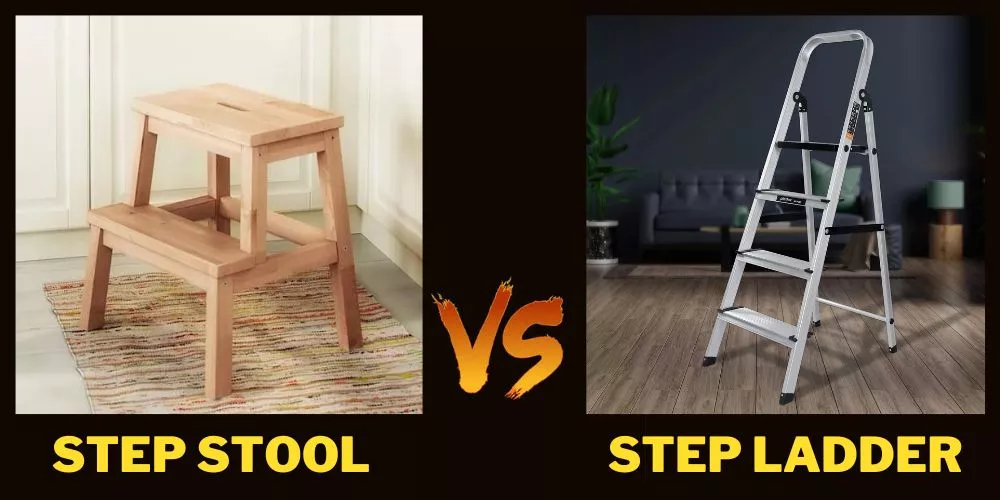When it comes to reaching those high shelves, changing a light bulb, or tackling a home project, the importance of a sturdy and reliable tool cannot be overstated.
Two popular options in this regard are step stools and step ladders. But how does one choose between these two versatile choices?
Let’s settle this step stool vs step ladder debate here once and for all.
In this article, we’ll take an in-depth look at the key differences between step stools and step ladders, exploring their respective advantages and drawbacks to help you determine the right one for your specific needs.

So, let’s step into the world of stools and ladders, and identify the perfect fit for you!
Step stool vs step ladder: Comparison
Understanding the unique characteristics of both step stools and step ladders will give you the clarity you need to determine which one is most suited to your needs.
Below, we explain their differences in several important areas:

🪜 Structure and Design
- Step Stools: These are essentially a single step or a few steps high, typically without any support for the upper body. Step stools are also often folding, compact items, designed for quick and easy storage.
- Step Ladders: Step ladders have a distinct A-frame design with steps on one side and typically a support or safety rail on the other. This rail often extends above the top step, enabling users to lean against it for balance.
🪜 Height and Reach
- Step Stools: They are ideal for tasks that need a little height, such as reaching the top shelf in a cupboard. For most step stools, the height ranges from one to three feet.
- Step Ladders: These offer more height, making them handy for tasks involving higher areas such as changing light bulbs or painting walls. Their height mostly ranges from four to twenty feet, sometimes even more.
🪜Safety
- Step Stools: They are more conducive to quick tasks and generally have smaller surfaces for you to stand on, which can pose risks if not used with care.
- Step Ladders: Their design includes a safety rail and wide steps, creating a much safer and stable experience.
🪜Storage and Movability
- Step Stools: Owing to their small size, they are easy to move around and store in a closet or under a bed.
- Step Ladders: Despite their foldability, they are generally larger and heavier, needing more storage space and effort to move them around.
🪜Versatility
- Step Stools: Limited in height, they are versatile in terms of placement. They work well indoors as well as outdoors.
- Step Ladders: Because of their extended height, they offer greater versatility in terms of the tasks they can be used for.
🪜Price
- Step Stools: These are usually budget-friendly, making them a good choice for those looking to save on cost.
- Step Ladders: These are more expensive in comparison, due to their larger size and complexity of design.
The choice between a step stool and a step ladder ultimately depends on your unique needs and circumstances. By comparing their features, you can make an informed decision that maximizes safety, efficiency and cost-effectiveness.
step stool vs step ladder: Which is Better?
To determine whether a step stool or a step ladder would be the most appropriate for you, you need to consider your specific needs, keeping in mind the distinctions we’ve covered above.
Here are few questions to guide your decision:
- What height is required for the tasks you’ll be performing? If you only need an added foot or so of height for tasks such as reaching a high shelf, a step stool might be the perfect fit. But if your tasks involve reaching significantly higher locations (e.g., painting a ceiling or pruning trees), you might need a step ladder.
- What is your storage capacity? If you’re tight on storage space, the compact size of a step stool might be more conducive to your situation. Step ladders, while foldable, require more storage space due to their larger size.
- What’s your budget? If cost-effectiveness is a significant factor for you, consider that step stools are generally more affordable than step ladders.
- Concerned about safety? While both are designed with safety in mind, step ladders, with their support rail and wide steps, provide added stability that can be comforting for those uncomfortable with heights.
Everyone’s needs will be different and will require different tools. Evaluate your requirements and choose accordingly. Remember, no matter whether you choose a step stool or ladder, safety should be your primary consideration!
Frequently Asked Questions (FAQs)
Does OSHA allow step stools?
Yes, the Occupational Safety and Health Administration (OSHA) does allow the use of step stools. However, there are specific regulations that need to be adhered to when using any form of portable ladder, including step stools. Users must ensure that the step stool is in good condition, stable, and not positioned on an unstable base. OSHA expects employers and workers using step stools to understand and adhere to all safety protocols.
How much weight can a step stool take?
The u003ca href=u0022https://theladderguide.com/type-1-ladder-weight-limit/u0022 data-type=u0022postu0022 data-id=u0022816u0022u003eweightu003c/au003e a step stool can bear primarily depends on its construction and design. However, most standard step stools are rated to hold up to 200 to 300 pounds. It’s crucial to check the specific weight rating for the particular step stool model before use. Overloading a step stool can lead to dangerous situations, including the risk of collapse or fall.
What are the OSHA requirements for step ladders in 2023?
As of now, OSHA’s requirements for step ladders in 2023 have not been specifically outlined or published. However, it’s safe to assume that existing standards will continue to apply. These include ensuring the ladder is in good condition, stable, and used on a level and stable surface. Additionally, guardrails and safety features should be intact, and only one person should climb the ladder at a time. Regular inspections are also a must for ensuring safety.
Are wooden step ladders OSHA approved?
Yes, wooden step ladders are OSHA approved, provided they meet OSHA’s specific safety regulations. This includes being kept in a good state, free from splits, sharp edges, or any hazardous defects that could pose a risk during use. The rungs must also be intact, fixed firmly into the side rails, and spaced at specific intervals for safety. It’s crucial that wooden ladders are never painted with a concealing color that could hide potential defects.
Conclusion:
Selecting between a step stool and a step ladder ultimately hinges on your specific needs. Step stools are compact, simple to use and perfect for lower heights. Step ladders, on the other hand, offer more height and stability at the cost of portability.
Both have their pros and cons, and understanding your requirements will lead you to the right choice. In the end, safety should be paramount, and whichever you choose should meet all safety standards. Always ensure you use them appropriately to avoid potential accidents.


